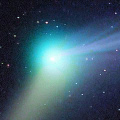
|
Now it is 6.3 mag (Jan. 15, Salvador Aguirre). It was expected to brighten up to 4-5 mag from autumn to winter. But actually, it is 6 mag at best. In the Northern Hemisphere, it will be observable in excellent condition after this. In the Southern Hemisphere, it is not observable after this.
Date(TT) R.A. (2000) Decl. Delta r Elong. m1 Best Time(A, h)
Jan. 16 13 52.35 51 41.5 0.726 1.372 105 6.4 3:20 (206, -4)
Jan. 23 13 7.79 69 31.1 0.751 1.465 114 6.7 3:29 (189,-15)
|
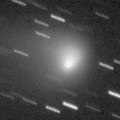
|
It brightened in outburst in early January. Now it is very bright as 8.3 mag (Jan. 14, Marek Biely). It will pass close to the earth from spring to summer, and it is expected to brighten up to 4-5 mag. In the Northern Hemisphere, it will be unobservable in late February. It will appear in the morning sky again in late April, but it locates low in the south around the high light. In the Southern Hemisphere, it will be unobservable soon. But after appearing in the morning sky again in mid April, it will be observable in excellent condition.
Date(TT) R.A. (2000) Decl. Delta r Elong. m1 Best Time(A, h)
Jan. 16 23 48.46 15 58.4 2.012 1.908 69 8.0 20:58 (113, 4)
Jan. 23 23 43.56 13 54.0 2.108 1.840 60 8.0 20:52 (107, 0)
|

|
Now it is so bright as 9.4 mag (Jan. 17, Carlos Labordena). It is observable at 9-10 mag until spring in excellent condition in the Northern Hemisphere. It keeps unobservable in the Southern Hemisphere.
Date(TT) R.A. (2000) Decl. Delta r Elong. m1 Best Time(A, h)
Jan. 16 16 54.68 62 56.8 1.895 2.146 90 9.0 3:20 (212,-30)
Jan. 23 16 50.33 63 55.7 1.882 2.164 92 9.1 3:29 (209,-26)
|
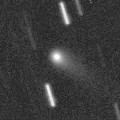
|
Now it is bright as 12.4 mag (Jan. 9, Seiichi Yoshida). It keeps 12 mag for a long time from 2015 autumn to 2016 summer. In the Northern Hemispehre, it keeps observable in good condition for a long time. It keeps unobservable in the Southern Hemisphere.
Date(TT) R.A. (2000) Decl. Delta r Elong. m1 Best Time(A, h)
Jan. 16 19 52.90 68 41.7 2.551 2.731 89 12.1 20:58 (156,-47)
Jan. 23 20 2.59 67 17.7 2.584 2.716 87 12.1 3:29 (206,-46)
|
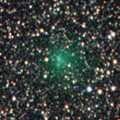
|
Now it is 11.8 mag (Jan. 8, Giuseppe Pappa). It keeps 11-13 mag until February. But it keeps very low.
Date(TT) R.A. (2000) Decl. Delta r Elong. m1 Best Time(A, h)
Jan. 16 22 28.35 -17 16.8 2.215 1.561 37 12.4 20:58 ( 75, 8)
Jan. 23 22 49.70 -15 28.5 2.273 1.592 36 12.6 20:52 ( 76, 7)
|
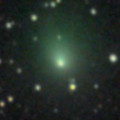
|
It is already unobservable in the Southern Hemisphere. It will be unobservable soon also in the Northern Hemisphere.
Date(TT) R.A. (2000) Decl. Delta r Elong. m1 Best Time(A, h)
Jan. 16 21 26.68 -16 46.2 2.620 1.765 23 12.6 20:58 ( 66, -4)
Jan. 23 21 45.81 -15 22.1 2.677 1.797 21 12.8 20:52 ( 67, -6)
|
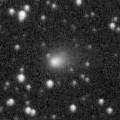
|
Now it is 12.5 mag (Jan. 8, Giuseppe Pappa). It will brighten up to 11 mag from spring to summer. In the Northern Hemisphere, it keeps observable in good condition while the comet will be brightening. It locates somewhat low in the Southern Hemisphere.
Date(TT) R.A. (2000) Decl. Delta r Elong. m1 Best Time(A, h)
Jan. 16 5 9.43 19 23.8 1.484 2.344 142 13.4 21:28 (180, 36)
Jan. 23 5 5.11 19 32.1 1.501 2.303 134 13.3 20:56 (180, 35)
|

|
It brightened up to 3.7 mag and became a naked eye comet in mid January in 2015 (Jan. 13, Marek Biely). Now it is fading. But it is bright as 12.5 mag still now (Dec. 9, Thomas Lehmann). In the Northern Hemisphere, it keeps observable for a long time until the comet fades out. It is not observable until March in the Southern Hemisphere.
Date(TT) R.A. (2000) Decl. Delta r Elong. m1 Best Time(A, h)
Jan. 16 18 2.81 19 59.5 5.117 4.526 48 13.5 3:20 (262,-24)
Jan. 23 18 7.99 20 3.8 5.150 4.593 50 13.5 3:29 (258,-18)
|
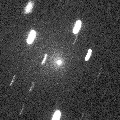
|
It passed near by the earth and brightened up to 12.1 mag from mid December to early January (Dec. 20, Thomas Lehmann). It is observable in excellent condition in the Northern Hemisphere. However, it will be fading rapidly after this. It is not observable in the Southern Hemisphere.
Date(TT) R.A. (2000) Decl. Delta r Elong. m1 Best Time(A, h)
Jan. 16 4 52.70 71 5.5 0.967 1.722 123 13.5 21:04 (180,-16)
Jan. 23 3 40.81 63 1.7 1.118 1.792 116 14.0 20:52 (171, -9)
|

|
Now it is 13.3 mag (Jan. 9, Seiichi Yoshida). It will brighten up to 13 mag from winter to spring. It will be observable in excellent condition in the Southern Hemisphere. But it locates somewhat low in the Northern Hemisphere.
Date(TT) R.A. (2000) Decl. Delta r Elong. m1 Best Time(A, h)
Jan. 16 14 36.53 -14 58.5 2.251 2.187 73 13.8 3:20 (262, 37)
Jan. 23 14 48.22 -16 1.3 2.176 2.189 77 13.7 3:29 (259, 43)
|

|
It is not observable now. It will appear in the morning sky in February.
Date(TT) R.A. (2000) Decl. Delta r Elong. m1 Best Time(A, h)
Jan. 16 18 51.74 -27 22.4 6.920 5.972 14 14.0 3:20 (308, -5)
Jan. 23 18 57.91 -27 12.4 6.887 5.970 19 14.0 3:29 (304, 0)
|
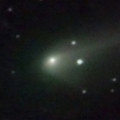
|
Now it is 13.3 mag (Dec. 8, Hiroshi Abe). It keeps observable in good condition after this, while the comet will be fading gradually.
Date(TT) R.A. (2000) Decl. Delta r Elong. m1 Best Time(A, h)
Jan. 16 12 23.62 7 31.9 1.558 2.136 112 14.1 3:20 (210, 43)
Jan. 23 12 23.64 7 50.8 1.531 2.190 119 14.3 3:29 (197, 46)
|

|
Now it is 14.8 mag (Nov. 22, Catalina Sky Survey). Distant object, but it keeps observable at 14-15 mag for a long time from 2015 to 2016. It becomes unobservable temporarily from January to March in the Southern Hemisphere, or from February to April in the Northern Hemisphere.
Date(TT) R.A. (2000) Decl. Delta r Elong. m1 Best Time(A, h)
Jan. 16 22 8.64 -6 45.8 5.728 4.976 36 14.8 20:58 ( 80, -2)
Jan. 23 22 15.38 -6 25.3 5.780 4.967 31 14.8 20:52 ( 78, -6)
|
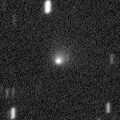
|
It keeps brightening even after the perihelion passage. Now it is 13.9 mag and visible visually (Jan. 9, Seiichi Yoshida). It keeps observable in excellent condition for a while. But it will be fading after this.
Date(TT) R.A. (2000) Decl. Delta r Elong. m1 Best Time(A, h)
Jan. 16 5 11.12 15 30.8 0.712 1.608 142 15.0 21:30 (180, 39)
Jan. 23 5 16.14 18 11.2 0.772 1.637 137 15.3 21:08 (180, 37)
|
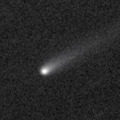
|
It brightened very rapidly in 2015 spring, and reached up to 13.8 mag (May 11, Sandor Szabo). It is bright as 15.5 mag still now (Dec. 20, Jean-Francois Soulier). It keeps 15-16 mag for a while until spring. It is observable in excellent condition in the Southern Hemisphere. But it locates somewhat low in the Northern Hemisphere.
Date(TT) R.A. (2000) Decl. Delta r Elong. m1 Best Time(A, h)
Jan. 16 13 58.37 -25 22.0 3.834 3.770 78 15.4 3:20 (269, 50)
Jan. 23 14 3.22 -26 9.4 3.756 3.792 84 15.4 3:29 (265, 57)
|
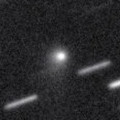
|
Now it is 15.7 mag (Dec. 19, Y. Sugiyama). It keeps 15-16 mag for a long time until 2016. It keeps observable in excellent condition in the Northern Hemisphere. It keeps unobservable in the Southern Hemisphere.
Date(TT) R.A. (2000) Decl. Delta r Elong. m1 Best Time(A, h)
Jan. 16 2 54.46 74 7.8 4.751 5.241 114 15.6 20:58 (173,-21)
Jan. 23 2 47.72 73 45.7 4.816 5.249 110 15.6 20:52 (171,-21)
|
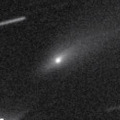
|
Now it is 15.8 mag (Dec. 7, Yuji Ohshima). In the Northern Hemisphere, it keeps observable after this while the comet will be fading. It will be getting higher gradually after this also in the Southern Hemisphere.
Date(TT) R.A. (2000) Decl. Delta r Elong. m1 Best Time(A, h)
Jan. 16 14 13.78 21 32.3 2.475 2.695 91 15.8 3:20 (227, 17)
Jan. 23 14 18.19 22 12.3 2.440 2.744 97 15.9 3:29 (220, 21)
|
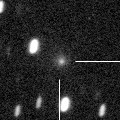
|
First return of a periodic comet discovered in 2003. Now it is 15.1 mag (Dec. 17, Space Surveillance Telescope, Atom Site). It will be fading after this, and will be fainter than 18 mag in March. It is observable in excellent condition in the Northern Hemisphere. It locates low in the Southern Hemisphere.
Date(TT) R.A. (2000) Decl. Delta r Elong. m1 Best Time(A, h)
Jan. 16 4 38.19 26 54.0 0.868 1.721 136 15.8 20:58 (180, 28)
Jan. 23 4 42.91 29 23.8 0.933 1.742 130 16.0 20:52 (176, 25)
|
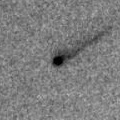
|
Now it is 16.7 mag (Dec. 11, D. Buczynski). It will brighten rapidly after this, and it will be observable at 14-15 mag in good condition from winter to summer.
Date(TT) R.A. (2000) Decl. Delta r Elong. m1 Best Time(A, h)
Jan. 16 13 28.25 0 39.8 2.178 2.464 94 16.0 3:20 (233, 40)
Jan. 23 13 33.59 -0 27.5 2.075 2.450 100 15.9 3:29 (225, 46)
|
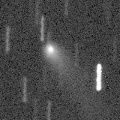
|
Now it is 15.3 mag (Dec. 13, D. Buczynski). It keeps 15 mag for a long time from 2014 to 2015. It is observable in excellent condition in the Northern Hemisphere. It will not be observable after this in the Southern Hemisphere.
Date(TT) R.A. (2000) Decl. Delta r Elong. m1 Best Time(A, h)
Jan. 16 0 32.69 45 48.6 4.547 4.699 92 16.0 20:58 (142, -8)
Jan. 23 0 35.46 45 54.7 4.669 4.732 87 16.1 20:52 (140,-11)
|
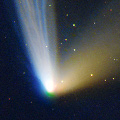
|
It approached to the sun down to 0.3 a.u. on July 6, 2015, and brighted up to 3.9 mag (July 6, Thomas Lehmann). Now it is fading. It has already faded down to 12.9 mag in October (Oct. 3, Chris Wyatt). No observations have been reported since November. In the Southern Hemisphere, it keeps observable until the comet fades out. It will not be observable after this in the Northern Hemisphere.
Date(TT) R.A. (2000) Decl. Delta r Elong. m1 Best Time(A, h)
Jan. 16 18 49.45 -57 11.2 4.118 3.393 37 16.0 3:20 (330, 16)
Jan. 23 19 3.59 -57 27.9 4.174 3.480 40 16.2 3:29 (328, 18)
|
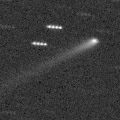
|
Now it is 15.4 mag (Dec. 8, Yasukazu Ikari). It will be fading slowly after this. It will be unobservable soon in the Southern Hemisphere. It will be unobservable in early March also in the Northern Hemisphere. But it will be observable again at 17 mag in good condition in autumn.
Date(TT) R.A. (2000) Decl. Delta r Elong. m1 Best Time(A, h)
Jan. 16 0 2.92 16 11.2 4.513 4.325 72 16.1 20:58 (115, 7)
Jan. 23 0 2.18 16 36.3 4.647 4.340 65 16.2 20:52 (112, 2)
|
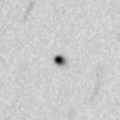
|
Now it is 16.0 mag (Dec. 12, J. Lozano). It is expected to brighten up to 7 mag in 2017 summer. In the Northern Hemisphere, it keeps observable in good condition until the highlight while the comet will be brightening. In the Southern Hemisphere, it is not observable until early 2017.
Date(TT) R.A. (2000) Decl. Delta r Elong. m1 Best Time(A, h)
Jan. 16 7 36.28 63 41.0 5.095 5.857 137 16.2 23:55 (180, -9)
Jan. 23 7 27.27 64 0.0 5.061 5.797 134 16.2 23:18 (180, -9)
|
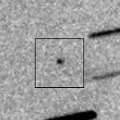
|
Now it is 18.6 mag (Dec. 17, A. Klotz, F. Kugel, C. Rinner). It will be observable at 11 mag in good condition from spring to summer.
Date(TT) R.A. (2000) Decl. Delta r Elong. m1 Best Time(A, h)
Jan. 16 12 17.72 13 28.7 1.762 2.360 115 16.6 3:20 (205, 38)
Jan. 23 12 22.46 13 46.0 1.649 2.319 121 16.2 3:29 (195, 40)
|

|
It brightened up to 11-12 mag in 2012. It has already faded down to 17.2 mag (Dec. 19, Yuji Ohshima). It is observable at 16-17 mag in good condition from winter to spring.
Date(TT) R.A. (2000) Decl. Delta r Elong. m1 Best Time(A, h)
Jan. 16 11 7.76 -7 8.0 10.216 10.790 123 16.3 3:20 (185, 62)
Jan. 23 11 5.19 -7 0.7 10.157 10.827 130 16.3 2:59 (180, 62)
|
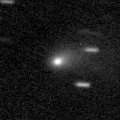
|
First return of a periodic comet discovered in 1994. It brightened up to 13.8 mag from summer to autumn (Sept. 7, Taras Prystavski). Now it is fading. It has already faded down to 16.1 mag (Dec. 11, MASTER-IAC Observatory, Tenerife). It is observable in excellent condition in the Southern Hemisphere. It locates somewhat low in the Northern Hemisphere.
Date(TT) R.A. (2000) Decl. Delta r Elong. m1 Best Time(A, h)
Jan. 16 23 58.83 -5 46.4 2.867 2.566 62 16.4 20:58 ( 97, 20)
Jan. 23 0 8.82 -3 57.8 2.961 2.585 58 16.5 20:52 ( 97, 16)
|
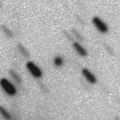
|
Now it is bright as 16.0 mag (Dec. 17, P. Bacci, L. Tesi, G. Fagioli). It keeps observable in good condition for a while.
Date(TT) R.A. (2000) Decl. Delta r Elong. m1 Best Time(A, h)
Jan. 16 5 37.52 15 35.8 2.573 3.451 148 16.4 21:56 (180, 39)
Jan. 23 5 35.33 14 50.4 2.641 3.462 141 16.5 21:26 (180, 40)
|
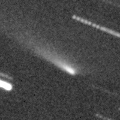
|
It brightened up to 12.0-12.5 mag from early December to early January (Dec. 8, Michael Jager). Now it must be fading very rapidly.
Date(TT) R.A. (2000) Decl. Delta r Elong. m1 Best Time(A, h)
Jan. 16 23 40.73 -0 15.3 1.168 1.095 60 16.5 20:58 ( 99, 13)
Jan. 23 0 16.19 2 51.2 1.266 1.195 62 17.2 20:52 (104, 14)
|

|
Now it is 19.6 mag (Dec. 14, K. Hills). It will brighten very rapidly and reach up to 11 mag in March. In this apparition, it keeps observable in excellent condition both brightening and fading period. In the Northern Hemisphere, it will be unobservable temporarily in mid March.
Date(TT) R.A. (2000) Decl. Delta r Elong. m1 Best Time(A, h)
Jan. 16 6 21.03 -14 56.0 0.369 1.282 138 16.9 22:39 (180, 70)
Jan. 23 6 12.57 -17 21.1 0.328 1.228 131 16.5 22:03 (180, 73)
|

|
Now it is 16.9 mag (Nov. 15, J. Bel). It will brighten up to 14 mag in summer. But it is not observable at the highlight. It keeps observable until March while the comet will be brightening gradually up to 15-16 mag.
Date(TT) R.A. (2000) Decl. Delta r Elong. m1 Best Time(A, h)
Jan. 16 0 52.28 -2 36.4 2.336 2.306 76 16.6 20:58 (109, 28)
Jan. 23 1 1.30 -1 30.7 2.393 2.281 71 16.5 20:52 (107, 25)
|
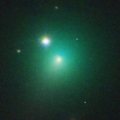
|
It brightened up to 8.8 mag in 2015 spring (Apr. 3, Marco Goiato). Now it is fading. It has already faded down to 15.9 mag (Dec. 15, S. Shurpakov). It keeps observable until March when the comet becomes fainter than 18 mag.
Date(TT) R.A. (2000) Decl. Delta r Elong. m1 Best Time(A, h)
Jan. 16 1 57.77 11 31.6 2.624 2.903 96 16.6 20:58 (133, 30)
Jan. 23 2 2.68 12 5.3 2.764 2.943 90 16.8 20:52 (130, 27)
|
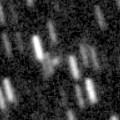
|
Now it is 17.0 mag (Nov. 3, A. Maury, J.-F. Soulier, J.-G. Bosch, T. Noel). It keeps 16.5 mag for a long time in 2016, and it will be observable in excellent condition in the Southern Hemisphere. It is hardly observable in the Northern Hemisphere.
Date(TT) R.A. (2000) Decl. Delta r Elong. m1 Best Time(A, h)
Jan. 16 5 38.71 -63 51.9 3.364 3.527 91 16.6 21:54 ( 0, 61)
Jan. 23 5 10.24 -62 55.2 3.374 3.508 89 16.6 20:59 ( 0, 62)
|
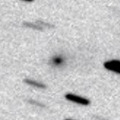
|
Now it is 16.8 mag (Dec. 18, Space Surveillance Telescope, Atom Site). It is observable at 16.5 mag in excellent condition from December to February. It locates somewhat low in the Southern Hemisphere.
Date(TT) R.A. (2000) Decl. Delta r Elong. m1 Best Time(A, h)
Jan. 16 8 29.79 21 31.4 0.976 1.953 170 16.6 0:52 (180, 34)
Jan. 23 8 25.78 22 27.6 0.979 1.963 176 16.6 0:21 (180, 33)
|
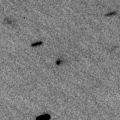
|
Now it is 16.9 mag (Nov. 17, J. Nicolas, C. Rinner, F. Kugel, A. Klotz). It will brighten up to 14 mag in 2017. In 2016, it keeps observable at 16 mag in good condition from winter to spring.
Date(TT) R.A. (2000) Decl. Delta r Elong. m1 Best Time(A, h)
Jan. 16 12 8.10 10 35.7 3.443 3.987 116 16.7 3:20 (203, 42)
Jan. 23 12 8.34 10 51.6 3.337 3.971 123 16.6 3:29 (191, 44)
|
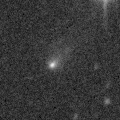
|
Now it is 16.5 mag (Dec. 20, Michael Jager). It must have been observable at 16-17 mag in good condition from summer to autumn in the Northern Hemisphere, but it was not discovered. It will be fading after this, and will be fainter than 18 mag in April.
Date(TT) R.A. (2000) Decl. Delta r Elong. m1 Best Time(A, h)
Jan. 16 12 48.50 35 1.2 1.826 2.397 113 16.6 3:20 (203, 15)
Jan. 23 12 40.52 34 39.6 1.782 2.436 120 16.6 3:29 (194, 19)
|
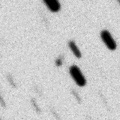
|
Now it is 16.9 mag (Dec. 13, K. Hills). It keeps 16-17 mag for a long time until 2016 autumn. In the Southern Hemisphere, it keeps observable in good condition for a long time. In the Northern Hemisphere, it is observable only until March.
Date(TT) R.A. (2000) Decl. Delta r Elong. m1 Best Time(A, h)
Jan. 16 4 1.06 -26 24.2 2.405 2.857 107 16.7 20:58 (133, 78)
Jan. 23 3 53.61 -27 7.6 2.458 2.813 100 16.6 20:52 (114, 73)
|
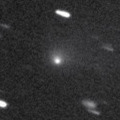
|
It brightened up to 14.5 mag in autumn (Nov. 11, Sandor Szabo). Now it is fading. It has already faded down to 16.7 mag (Dec. 14, L. Elenin). It will be fainter than 18 mag in March.
Date(TT) R.A. (2000) Decl. Delta r Elong. m1 Best Time(A, h)
Jan. 16 2 33.62 7 20.0 1.824 2.262 103 16.7 20:58 (139, 38)
Jan. 23 2 41.23 8 14.1 1.922 2.281 98 16.9 20:52 (136, 36)
|
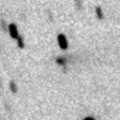
|
Now it is 17.0 mag (Dec. 16, Purple Mountain Observatory). It is observable at 17 mag in good condition in winter.
Date(TT) R.A. (2000) Decl. Delta r Elong. m1 Best Time(A, h)
Jan. 16 8 10.13 20 33.7 1.370 2.352 174 16.9 0:33 (180, 35)
Jan. 23 8 4.87 22 5.0 1.368 2.351 176 16.9 0:00 (180, 33)
|
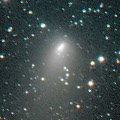
|
It brightened up to 10.4 mag from July to August (July 18, Maik Meyer). Now it is fading. It has already faded down to 16.0 mag (Dec. 8, Yasukazu Ikari). It is observable in good condition in the Northern Hemisphere. It is not observable in the Southern Hemisphere.
Date(TT) R.A. (2000) Decl. Delta r Elong. m1 Best Time(A, h)
Jan. 16 23 17.83 46 55.5 2.524 2.592 82 17.0 20:58 (135,-19)
Jan. 23 23 37.45 46 55.8 2.637 2.656 80 17.2 20:52 (135,-19)
|
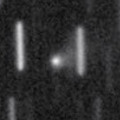
|
Brightening very rapidly, and it keeps brightening even after the perihelion passage. Now it is very bright as 15.9 mag (Dec. 16, Catalina Sky Survey). It keeps observable in excellent condition for a while.
Date(TT) R.A. (2000) Decl. Delta r Elong. m1 Best Time(A, h)
Jan. 16 5 47.91 -14 28.2 1.280 2.086 133 17.1 22:06 (180, 69)
Jan. 23 5 46.47 -13 22.7 1.344 2.117 130 17.3 21:37 (180, 68)
|

|
First return of an object discovered as an asteroid 2007 VA85 in 2007. Faint tail was observed on Jan. 8 by Hidetaka Sato. Now it is 17.2 mag (Jan. 10, E. Bryssinck). It will approach to the earth down to 0.5 a.u., will brighten up to 15-16 mag, and will be observable in excellent condition.
Date(TT) R.A. (2000) Decl. Delta r Elong. m1 Best Time(A, h)
Jan. 16 11 13.41 -47 51.2 1.063 1.535 97 17.6 3:20 (348, 77)
Jan. 23 10 30.81 -48 56.2 0.871 1.476 105 17.1 2:27 ( 0, 76)
|
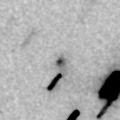
|
Now it is 17.5 mag (Dec. 17, Space Surveillance Telescope, Atom Site). It keeps observable at 17.5 mag in good condition from winter to spring in the Northern Hemispehre. It is observable only until mid February in the Southern Hemisphere.
Date(TT) R.A. (2000) Decl. Delta r Elong. m1 Best Time(A, h)
Jan. 16 7 46.78 25 8.8 1.646 2.628 175 17.3 0:10 (180, 30)
Jan. 23 7 30.85 29 13.0 1.623 2.588 165 17.2 23:20 (180, 25)
|

|
It brightened up to 13 mag in 2014. Now it is 16.0 mag (Dec. 16, Yasukazu Ikari). It will be fading after this, and will be fainter than 18 mag in spring.
Date(TT) R.A. (2000) Decl. Delta r Elong. m1 Best Time(A, h)
Jan. 16 1 4.92 2 17.9 4.192 4.151 80 17.2 20:58 (115, 28)
Jan. 23 1 8.78 2 55.0 4.313 4.165 74 17.3 20:52 (112, 24)
|
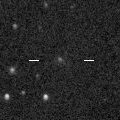
|
Now it is 17.2 mag (Nov. 18, Catalina Sky Survey). Now it is near the aphelion. It is observable at 17 mag in good condition from autumn to winter.
Date(TT) R.A. (2000) Decl. Delta r Elong. m1 Best Time(A, h)
Jan. 16 3 7.03 15 21.1 3.717 4.208 113 17.3 20:58 (153, 35)
Jan. 23 3 7.57 15 32.8 3.811 4.200 106 17.4 20:52 (147, 33)
|

|
Now it is 18.3 mag (Nov. 15, Hidetaka Sato). It keeps observable at 17 mag in good condition from winter to spring.
Date(TT) R.A. (2000) Decl. Delta r Elong. m1 Best Time(A, h)
Jan. 16 14 29.16 2 51.1 2.448 2.499 81 17.4 3:20 (244, 28)
Jan. 23 14 38.02 2 32.0 2.370 2.504 86 17.3 3:29 (239, 33)
|

|
It has not been observed yet in this apparition. It tends to be brightest after the perihelion passage. It is observable at 17 mag in excellent condition until March in the Northern Hemisphere. It locates low in the Southern Hemisphere.
Date(TT) R.A. (2000) Decl. Delta r Elong. m1 Best Time(A, h)
Jan. 16 4 53.20 43 56.2 0.905 1.760 137 17.4 21:12 (180, 11)
Jan. 23 4 55.95 42 54.3 0.924 1.743 131 17.3 20:52 (179, 12)
|
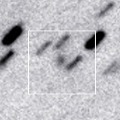
|
Now it is 16.9 mag (Dec. 19, Y. Sugiyama). It keeps 17.5 mag for a long time from 2016 to 2019. It keeps locating near by the equator.
Date(TT) R.A. (2000) Decl. Delta r Elong. m1 Best Time(A, h)
Jan. 16 8 7.89 -0 35.0 9.208 10.125 157 17.4 0:30 (180, 56)
Jan. 23 8 6.19 -0 23.4 9.183 10.112 159 17.4 0:01 (180, 55)
|
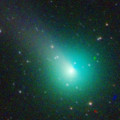
|
It brightened up to 6.0 mag in mid May (May 14, Chris Wyatt). Now it is fading. It has already faded down to 16.4 mag (Dec. 7, Yasukazu Ikari). In the Northern Hemisphere, it keeps observable in good condition after this while the comet will be fading. It locates somewhat low in the Southern Hemisphere.
Date(TT) R.A. (2000) Decl. Delta r Elong. m1 Best Time(A, h)
Jan. 16 5 23.92 38 24.6 2.751 3.598 144 17.4 21:42 (180, 17)
Jan. 23 5 11.54 38 8.3 2.907 3.677 135 17.6 21:02 (180, 17)
|

|
Now it is 17.4 mag (Dec. 11, Purple Mountain Observatory). It will brighten up to 13 mag in summer. But it is not observable around the highlight. In the Southern Hemisphere, it is observable until February when it brightens up to 17 mag. In the Northern Hemisphere, it is observable until April when it brightens up to 16 mag.
Date(TT) R.A. (2000) Decl. Delta r Elong. m1 Best Time(A, h)
Jan. 16 1 55.09 10 50.2 2.991 3.237 95 17.5 20:58 (132, 30)
Jan. 23 1 57.69 10 51.4 3.027 3.166 88 17.4 20:52 (128, 27)
|
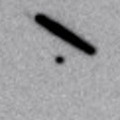
|
Now it is 17.1 mag (Dec. 13, D. Buczynski). It is observable in good condition in the Northern Hemisphere. It is not observable in the Southern Hemisphere.
Date(TT) R.A. (2000) Decl. Delta r Elong. m1 Best Time(A, h)
Jan. 16 11 28.58 50 35.8 1.570 2.310 128 17.5 3:20 (185, 4)
Jan. 23 11 20.40 51 48.4 1.583 2.359 132 17.5 3:15 (180, 3)
|
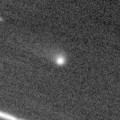
|
It brightened up to 16 mag in early 2015. Now it is 18.1 mag (Dec. 12, ATLAS-HKO, Haleakala). It is observable at 18 mag from winter to spring.
Date(TT) R.A. (2000) Decl. Delta r Elong. m1 Best Time(A, h)
Jan. 16 10 11.59 -24 51.1 5.398 5.982 122 17.6 2:34 (180, 80)
Jan. 23 10 3.84 -24 52.0 5.342 6.005 128 17.6 1:58 (180, 80)
|
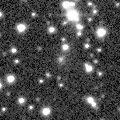
|
It will pass the perihelion in 2019. However, it has not been brightening since the discovery in 2010. Now it is 17.6 mag (Dec. 3, D. Buczynski). It keeps observable in excellent condition from autumn to next spring in the Northern Hemisphere. It is not observable in the Southern Hemisphere.
Date(TT) R.A. (2000) Decl. Delta r Elong. m1 Best Time(A, h)
Jan. 16 3 9.75 47 19.0 10.197 10.709 119 17.7 20:58 (165, 5)
Jan. 23 3 8.77 47 11.3 10.264 10.685 112 17.7 20:52 (161, 4)
|
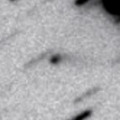
|
Now it is 17.6 mag (Dec. 17, A. Hidas). It keeps 17-18 mag for a long time until 2017 spring.
Date(TT) R.A. (2000) Decl. Delta r Elong. m1 Best Time(A, h)
Jan. 16 6 49.23 -26 17.5 3.367 4.075 130 17.7 23:07 (180, 81)
Jan. 23 6 45.10 -24 58.4 3.346 4.049 129 17.7 22:36 (180, 80)
|
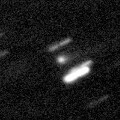
|
It brightened up to 15.2 mag in early 2015 (Feb. 24, Toshiyuki Takahashi). Now it is 17.5 mag (Dec. 6, Catalina Sky Survey). It will be fainter than 18 mag in April.
Date(TT) R.A. (2000) Decl. Delta r Elong. m1 Best Time(A, h)
Jan. 16 11 43.11 -6 9.8 4.190 4.708 116 17.7 3:20 (203, 59)
Jan. 23 11 42.71 -6 16.9 4.114 4.726 123 17.7 3:29 (184, 61)
|
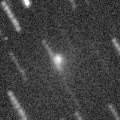
|
Now it is 16.9 mag (Dec. 16, Yasukazu Ikari). It wil be fainter than 18 mag soon.
Date(TT) R.A. (2000) Decl. Delta r Elong. m1 Best Time(A, h)
Jan. 16 1 38.21 25 58.3 2.217 2.533 97 17.8 20:58 (139, 16)
Jan. 23 1 44.66 23 22.4 2.376 2.580 90 18.0 20:52 (134, 15)
|
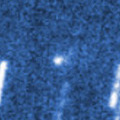
|
Now it is 17.8 mag (Dec. 18, Hidetaka Sato). It keeps observable at 17.5 mag in good condition until April.
Date(TT) R.A. (2000) Decl. Delta r Elong. m1 Best Time(A, h)
Jan. 16 9 4.60 -3 44.8 1.938 2.826 148 17.9 1:27 (180, 59)
Jan. 23 8 57.82 -0 51.3 1.859 2.792 157 17.8 0:53 (180, 56)
|

|
Now it is 17.7 mag (Nov. 30, Hidetaka Sato). It was expected to brighten up to 14 mag from winter to summer. But it is much fainter actually. It will be observable in excellent condition in the Southern Hemisphere. It locates low in the Northern Hemisphere.
Date(TT) R.A. (2000) Decl. Delta r Elong. m1 Best Time(A, h)
Jan. 16 14 50.95 -16 47.9 2.384 2.242 69 17.9 3:20 (266, 35)
Jan. 23 15 3.70 -18 28.1 2.315 2.243 73 17.9 3:29 (264, 41)
|
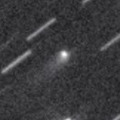
|
It keeps 17-18 mag for a long time since 2013. In the Northern Hemisphere, it is observable at 18 mag in good condition also in this winter. It is not observable in the Southern Hemisphere.
Date(TT) R.A. (2000) Decl. Delta r Elong. m1 Best Time(A, h)
Jan. 16 14 27.02 56 41.4 7.050 7.325 102 17.9 3:20 (206,-12)
Jan. 23 14 24.60 57 37.0 7.020 7.346 105 17.9 3:29 (201, -9)
|
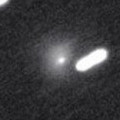
|
Very far object. Outburst occured on Feb. 20, 2015, and it brightened up to 15 mag. But it is faint as 18 mag now. It is observable in excellent condition in the Southern Hemisphere. It locates somewhat low in the Northern Hemisphere.
Date(TT) R.A. (2000) Decl. Delta r Elong. m1 Best Time(A, h)
Jan. 16 13 31.15 -25 35.9 9.186 9.146 84 17.9 3:20 (265, 56)
Jan. 23 13 32.26 -25 49.3 9.074 9.147 91 17.9 3:29 (258, 63)
|

|
Now it is 19.0 mag (Jan. 10, B. Lutkenhoner). The brightness differs in every apparition. It was not observed in the last apparition. In this apparition, it was expected to be observable at 14-15 mag from winter to spring. But it will be 17 mag at best. It locates extremely low in the Southern Hemisphere.
Date(TT) R.A. (2000) Decl. Delta r Elong. m1 Best Time(A, h)
Jan. 16 22 56.35 -1 14.8 1.898 1.473 50 18.9 20:58 ( 92, 4)
Jan. 23 23 14.68 -0 0.2 1.891 1.426 47 18.7 20:52 ( 92, 3)
|

|
First return of a periodic comet which brightened up to 8 mag in major outburst in 2010. It will be observable in excellent condition from winter to spring. However, now it is so faint; the fragment A is 17.9 mag and the fragment B is 18.2 mag (Jan. 15, Toshiyuki Takahashi). It will be 18-19 mag at best in this apparition. Pieter-Jan Dekelver reported the fragments C and D are also visible at 21-22 mag.
Date(TT) R.A. (2000) Decl. Delta r Elong. m1 Best Time(A, h)
Jan. 16 9 10.66 36 48.1 0.730 1.677 156 19.1 1:33 (180, 18)
Jan. 23 9 7.27 36 56.6 0.697 1.656 159 18.9 1:02 (180, 18)
|
|
![]()
 29P/Schwassmann-Wachmann 1
29P/Schwassmann-Wachmann 1 67P/Churyumov-Gerasimenko
67P/Churyumov-Gerasimenko C/2011 KP36 ( Spacewatch )
C/2011 KP36 ( Spacewatch ) 230P/LINEAR
230P/LINEAR C/2014 W11 ( PanSTARRS )
C/2014 W11 ( PanSTARRS ) C/2013 V4 ( Catalina )
C/2013 V4 ( Catalina ) 19P/Borrelly
19P/Borrelly 329P/2015 T1 ( LINEAR-Catalina )
329P/2015 T1 ( LINEAR-Catalina ) 77P/Longmore
77P/Longmore C/2014 N3 ( NEOWISE )
C/2014 N3 ( NEOWISE ) C/2014 Q1 ( PanSTARRS )
C/2014 Q1 ( PanSTARRS ) C/2014 A4 ( SONEAR )
C/2014 A4 ( SONEAR ) C/2015 V2 ( Johnson )
C/2015 V2 ( Johnson ) 9P/Tempel 1
9P/Tempel 1 C/2006 S3 ( LONEOS )
C/2006 S3 ( LONEOS ) 318P/2014 M6 ( McNaught-Hartley )
318P/2014 M6 ( McNaught-Hartley ) C/2015 X4 ( Elenin )
C/2015 X4 ( Elenin ) 249P/LINEAR
249P/LINEAR 252P/LINEAR
252P/LINEAR 118P/Shoemaker-Levy 4
118P/Shoemaker-Levy 4 88P/Howell
88P/Howell C/2015 B2 ( PanSTARRS )
C/2015 B2 ( PanSTARRS ) 204P/LINEAR-NEAT
204P/LINEAR-NEAT 65P/Gunn
65P/Gunn C/2015 YG1 ( NEOWISE )
C/2015 YG1 ( NEOWISE ) C/2015 T4 ( PanSTARRS )
C/2015 T4 ( PanSTARRS ) 61P/Shajn-Schaldach
61P/Shajn-Schaldach 211P/Hill
211P/Hill C/2015 F4 ( Jacques )
C/2015 F4 ( Jacques ) P/2015 Q1 ( Scotti )
P/2015 Q1 ( Scotti ) 332P/LINEAR
332P/LINEAR C/2015 W1 ( Gibbs )
C/2015 W1 ( Gibbs ) 117P/Helin-Roman-Alu 1
117P/Helin-Roman-Alu 1 74P/Smirnova-Chernykh
74P/Smirnova-Chernykh 180P/NEAT
180P/NEAT 194P/LINEAR
194P/LINEAR C/2014 B1 ( Schwartz )
C/2014 B1 ( Schwartz ) C/2015 G2 ( MASTER )
C/2015 G2 ( MASTER ) C/2015 TQ209 ( LINEAR )
C/2015 TQ209 ( LINEAR ) 162P/Siding Spring
162P/Siding Spring C/2013 G9 ( Tenagra )
C/2013 G9 ( Tenagra ) C/2010 U3 ( Boattini )
C/2010 U3 ( Boattini ) C/2015 X7 ( ATLAS )
C/2015 X7 ( ATLAS ) 269P/2012 R2 ( Jedicke )
269P/2012 R2 ( Jedicke ) C/2015 GX ( PanSTARRS )
C/2015 GX ( PanSTARRS ) C/2015 Y1 ( LINEAR )
C/2015 Y1 ( LINEAR ) C/2014 Y1 ( PanSTARRS )
C/2014 Y1 ( PanSTARRS ) C/2012 K8 ( Lemmon )
C/2012 K8 ( Lemmon ) C/2013 C2 ( Tenagra )
C/2013 C2 ( Tenagra ) 104P/Kowal 2
104P/Kowal 2 331P/2015 Y2 ( Ikeya-Murakami )
331P/2015 Y2 ( Ikeya-Murakami )![]()





















































